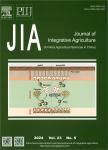Design of a spatial sampling scheme considering the spatial autocorrelation of crop acreage included in the sampling units
Design of a spatial sampling scheme considering the spatial autocorrelation of crop acreage included in the sampling units作者机构:Key Laboratory of Agricultural Remote Sensing Ministry of Agriculture/Institute of Agricultural Resources and Regional PlanningChinese Academy of Agricultural Sciences
出 版 物:《Journal of Integrative Agriculture》 (农业科学学报(英文版))
年 卷 期:2018年第17卷第9期
页 面:2096-2106页
核心收录:
学科分类:082804[工学-农业电气化与自动化] 08[工学] 0710[理学-生物学] 0832[工学-食品科学与工程(可授工学、农学学位)] 0830[工学-环境科学与工程(可授工学、理学、农学学位)] 1004[医学-公共卫生与预防医学(可授医学、理学学位)] 0828[工学-农业工程] 0905[农学-畜牧学] 0906[农学-兽医学] 0901[农学-作物学] 0703[理学-化学] 0902[农学-园艺学] 0713[理学-生态学]
基 金:financially supported by the National Natural Science Foundation of China (41471365 41531179)
主 题:crop acreage spatial autocorrelation sampling unit planting intensity cultivated land fragmentation ground slope
摘 要:Information on crop acreage is important for formulating national food polices and economic planning. Spatial sampling, a combination of traditional sampling methods and remote sensing and geographic information system (GIS) technology, provides an efficient way to estimate crop acreage at the regional scale. Traditional sampling methods require that the sampling units should be independent of each other, but in practice there is often spatial autocorrelation among crop acreage contained in the sampling units. In this study, using Dehui County in Jilin Province, China, as the study area, we used a thematic crop map derived from Systeme Probatoire d'Observation de la Terre (SPOT-5) imagery, cultivated land plots and digital elevation model data to explore the spatial autocorrelation characteristics among maize and rice acreage included in sampling units of different sizes, and analyzed the effects of different stratification criteria on the level of spatial autocorrelation of the two crop acreages within the sampling units. Moran's/, a global spatial autocorrelation index, was used to evaluate the spatial autocorrelation among the two crop acreages in this study. The results showed that although the spatial autocorrelation level among maize and rice acreages within the sampling units generally decreased with increasing sampling unit size, there was still a significant spatial autocorrelation among the two crop acreages included in the sampling units (Moran's / varied from 0.49 to 0.89), irrespective of the sampling unit size. When the sampling unit size was less than 3000 m, the stratification design that used crop planting intensity (CPI) as the stratification criterion, with a stratum number of 5 and a stratum interval of 20% decreased the spatial autocorrelation level to almost zero for the maize and rice area included in sampling units within each stratum. Therefore, the traditional sampling methods can be used to estimate the two crop acreages. Compared with CPI, there was still a strong spatial correlation among the two crop acreages included in the sampling units belonging to each stratum when cultivated land fragmentation and ground slope were used as stratification criterion. As far as the selection of stratification criteria and sampling unit size is concerned, this study provides a basis for formulating a reasonable spatial sampling scheme to estimate crop acreage.



